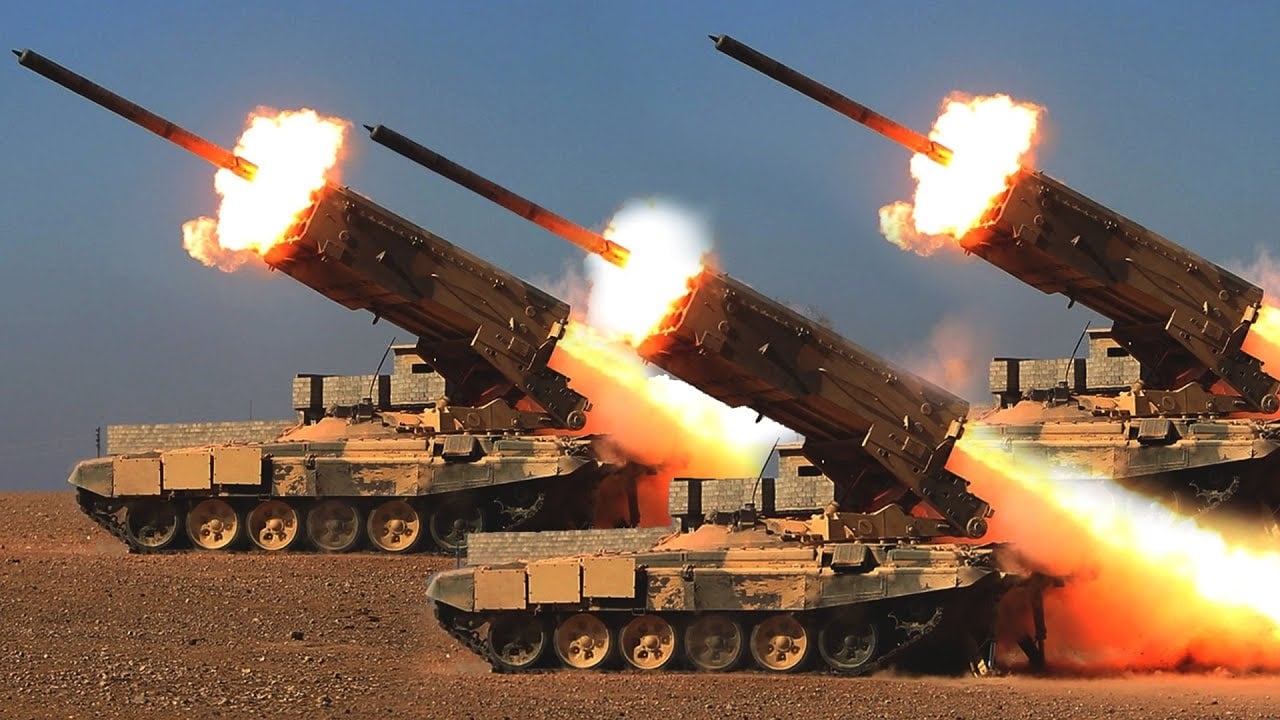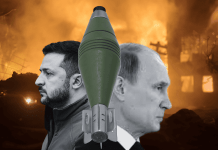Some Ukrainian officials have claimed that Russia was arming its Geran-2 or the Shahed-136 kamikaze drone with a thermobaric warhead at a time when the drone attacks on Ukraine have seen an uptick, sounding the bugle for another harsh winter ahead.
A photograph appeared on social media on December 3 with a message that suggested that Ukrainian insiders believe Russia had developed a 40-kilogram thermobaric warhead for the Geran-2 or Shahed-136 kamikaze drone, making it analogous to the TOS-1A flamethrower.
EurAsian Times could not independently verify these claims when writing this report. However, if the use of a thermobaric bomb by Geran-2 drones is eventually confirmed, it could come as a massive threat to the Ukrainians due to the bomb’s lethality.
Having two different explosive charges, thermobaric weapons are mostly made of fuel, not oxygen, as is the case with other bombs. This allows them to carry more energy and be more destructive in field operations to blow up bunkers, tunnels, and foxholes. These bombs could blow up residential buildings and could be detrimental to the safety of civilians.
The weapon can be dropped from an airplane or launched like a rocket. Upon impact, the main explosive charge bursts open the container, dispersing the fuel mixture like a cloud. This cloud can get through partially sealed defenses or openings in buildings.
That dust cloud is then destroyed by a second charge, which also creates a massive blast wave, a firestorm, and a vacuum that absorbs all the oxygen in the area.
New Russian thermobaric warhead for Shahed-136 (Geran-2) kamikaze UAVs weighing 40 kg.
Such a warhead is capable of demolishing part of a residential building, which makes the UAV actually an analogue of TOS-1A ammunition. pic.twitter.com/aQU5QMAyIe
— Clash Report (@clashreport) December 3, 2023
The development has been reported as Russia continues to unleash swarms of Shahed-136 suicide drones on Ukraine. EurAsian Times had earlier reported on the biggest ever Shahed 136 attack on the capital Kyiv, which appeared to be a message to Ukraine that Moscow will likely bombard Kyiv’s energy infrastructure using its suicide drones again this winter.
Ukraine has since reported the downing of several Shahed-136 drones in the western and southern parts of the country. In a recent development, one of these drones was also found with a Ukrainian SIM card, suggesting that it was used to operate the attack drone.
If these attacks have already been giving a hard time to Ukrainian forces, the addition of a thermobaric drone could cause double trouble, as has been demonstrated by Russia’s deployment and use of the TOS-1A Multiple Launch Rocket System which wreaked havoc on the country.
Since the beginning of the Ukrainian conflict, Russia has been utilizing thermobaric rocket launchers on Ukraine. On March 3, the Russian defense ministry announced that their airborne units were now equipped with the formidable TOS-1A Solntsepek.

The terror unleashed by this weapon system, which has no analogs in the world, according to Russia, has also motivated Ukrainian troops to eradicate this system. Several reports published over the months have suggested that Ukrainian drones were especially seeking TOS-1A Solntsepek as targets.
Previously, US-based defense expert David Hambling suggested that the best way to defeat this weapon system is to swiftly detect its location and obliterate the launchers before they get into action.
Furthermore, the Russian Defense Ministry has also noted earlier that the thermobaric bombs have a devastating impact, including the destruction of infrastructure and the potential for significant harm to internal organs and flash burns, ultimately leading to the death of those exposed. This impact is primarily due to the thermobaric weapons which Shahed-136 reportedly employs.
Furthermore, Ukraine fears that the coming winter may bring another drone onslaught due to Russia’s concerted efforts to boost domestic drone production. Published earlier this month, satellite images showed that construction is underway at a Russian complex that will mass-produce kamikaze drones designed in Iran.
NATO Chief Said Bad News From Ukraine Possible
As Kyiv continues to repel Russia’s full-scale invasion, NATO Secretary-General Jens Stoltenberg issued a warning, cautioning the Western military alliance to be prepared for terrible news from the Ukrainian front.
Stoltenberg said “wars develop in phases” during a weekend interview with German television station ARD. “We have to support Ukraine in good and bad times,” he stated. Without providing any details, Stoltenberg continued, “We should also be ready for bad news.”
His remarks coincide with Moscow’s increased force numbers and the debate among Western partners about ammunition and financial support for Ukraine. Last week, Russian President Vladimir Putin signed an order bringing the country’s troop count to 1.3 million, an increase of about 170,000.
Despite Kyiv’s summer counteroffensive, little has recently happened on the front lines. However, the Ukrainians have inflicted damage deep inside Russian territory by using cruise missiles to drive back the Russian fleet in the Black Sea.
The Russian MoD announced Friday that the authorized strength of the Russian military had increased by another 170,000 soldiers. This will allow the Russians to deploy an army on their unengaged right flank of approximately equal size to that currently fighting in Ukraine.⬇️… pic.twitter.com/TofKthcUuA
— Armchair Warlord (@ArmchairW) December 4, 2023
Bemoaning the fragmented state of Europe’s defense sector, Stoltenberg called on NATO nations to increase ammunition production. He called on nations to think beyond their own national interests and take the larger picture into consideration, saying that “we’re not able to work as closely together as we should.”
According to Stoltenberg, a Putin triumph would not only be disastrous for Ukraine but also pose a threat to the other countries. “The war will end faster the more we support Ukraine.
- Contact the author at sakshi.tiwari9555 (at) gmail.com
- Follow EurAsian Times on Google News




